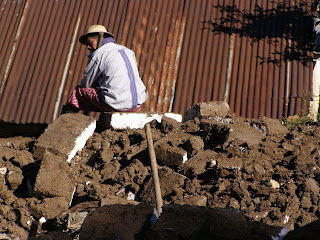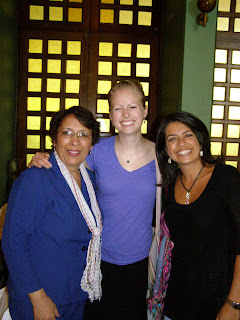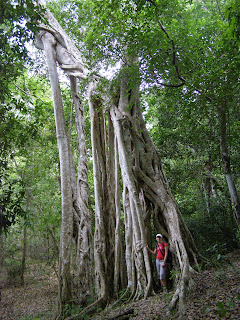Comme promis, j’écris en français cette fois-ci. Je commence meme là-dedans. C’est approprié, considérant que je parle plus en français en ce moment qu’en anglais (explications à suivre!). Je me trouve en ce moment à Guatemala City, après avoir parti de Todos Santos le 25 mai, et en passant par Antigua pour quelques jours. On a fini le comptage de chiens errants le matin du 24. Rendu ce point-là, j’avais des pancements sur toutes mes orteilles du pied gauche (qui restaient plusieurs jours sans tomber- vive les produits de haute gamme!), et pauvre Kate avait l’air de jamais vouloir voir une autre colline! On a passé notre dernier après-midi à Todos Santos à finir nos dernières petites tâches, à retourner les matériaux chez Benita, et à prendre un thé chez Élodie (une canadienne qui travail comme bénévole à Todos Santos sur l’alphébetisme des femmes). Ce soir-là, on est également retourné voir “Blanco”, un chien qu’on avait opéré pour un paraphimosis il y avait quelques jours. Ça faisait quelques mois que Blanco avait des problèmes avec son pénis, et Kate a décidé d’essayer une operation. On a fait le mieux qu’on pouvait sous les conditions, mais il restait quand meme intéressant faire une operation avec des canards qui se promenaient aux alentours et avec des propriétaires qui nous posaient des questions en Mam, qui étaient traduits en espagnol par un traducteur qu’on a engagé, et ensuite traduits en anglais pour Kate (par moi-même). Kate a même eu l’idée de faire un collier Élizabethain avec un seau découpé! Malgré toutes nos bonnes intentions, et celles des propriétaires, Blanco a réussi à enlever son collier le lendemain de la chirurgie, et a retracté de nouveau son prepuce. Quand on lui a laissé dimanche soir, il semblait en forme, sauf qu’il était dans le même état que dans lequel il avait été auparavant.

La référence au chuj était de mon experience ma dernière nuit à Todos Santos. Un chuj c’est un genre de sauna Mayen, dont la plupart des maisons du village en posedaient. Ils sont faits dans plusieurs formes différentes, mais celui-ci en particulier (à l’hôtel où je restais) était fait de béton, des dimensions d’environ 6 x 3 pieds pour la base, et d’environ 4 pieds en hauteur. Le toit n’a pas de trou, alors quand on prepare le feu, il faut laisser la porte ouverte pour laisser partir la fumée. Quand on entre (il faut se pencher, car la porte mesure à peine 3 pieds), on s’asseoit sur un banc à l’intérieur, et on s’en sert d’un basin d’eau pour verser de l’eau sur les roches chaudes. Traditionnellement, c’est une façon de se nettoyer. J’ai beaucoup aimé l’expérience (l’odeur intense du bois, l’ambiance, etc), mais j’ai quand même pris une douche par après!
On est parti de Todos Santos le matin de lundi le 29 à 4h30 sur un chicken bus (autobus écolier bien rempli du monde!), passant par Huehue, pregnant ensuite un coach jusqu’à Chimaltenango, et ensuite un autre bus, arrivant à Antigua vers 13h00. On a mange une excellente pizza en arrivant, le premier repas pour Nick depuis quelques jours (il trouvait ça un peu difficile manger à Todos Santos- je pense une combinaison des odeurs, des mouches et des conditions peu sanitaires). Je dois avouer qu’après une semaine basée autour du riz que la pizza était très bienvenue! C’était un peu le choc culturel arrivant à Antigua. C’est une ville très propre, très touristique, et plutôt riche.
Malheureusement, Kate a du nous quitter pour retourner un peu tôt au Canada pour des imprévues. Je jouais alors tourist avec Nick pendant quelques jours à Antigua avant qu’il prenne son avion et que je commence la prochaine partie de mon stage. On a beaucoup marché, on a visité les musées et églises essentielles, et surtout on a beaucoup mange. Notre mission: manger autant de nourriture riche et grasse que possible dans une période de 2 jours. Réussite totale! J’ai quand même continué le randonné, en grimpant le volcan Pacaya, l’un de 3 volcans actifs du pays. C’était assez fou se trouver à une mètre du feu chaud, dans un paysage semblable à Mordor du Seigneur des Anneaux.

Ma réalité a beaucoup change encore une fois jeudi matin, quand j’ai laissé Nick à l’aéroport pour me rendre au bureau de l’OPS (organization panaméricaine pour la santé). Je passerai les 2 prochains mois sous la direction de Dr. Raymond Dugas, un québecois qui travail dans l’international depuis plusieurs années, et qui travail en ce moment dans la division des zoonoses. J’ai commencé à travailler sur le dossier de la rage en travaillant sur un brouillon d’un guide d’éducation qui sera utilisé par les professeurs à travers le Guatemala pour expliquer aux enfants comment bien garder des chiens, comment interpréter leur comportement (dans le but d’éviter des morsures) et quoi faire en cas de morsure. Dr. Dugas, très gentillement, me loge chez lui pour le moment. Ma chambre dans son bel apart est un peu different de celle que j’avais à Todos Santos!
Guatemala City n’est pas très sécuritaire comme ville, alors je ne me promène jamais seule. J’étais contente de changer un peu de la routine lundi, en allant avec l’autre interne de Dr. Dugas, Manuel, à analyser des échantillons de celles pour des parasites bovins. C’est un nouveau gradué de la Faculté de medicine vétérinaire de l’Université San Carlos qui fait son effort pour m’apprendre les môts Guatémaltèques essentiels. Entre le français parlé à la maison et l’espagnol au bureau, je ferai mon mieux de retourner pas trop mélée à la fin!
***
Sorry, I couldn’t help but throw in the pun! I currently find myself in Guatemala City, having left Todos Santos on May 25th and spending a couple of days in Antigua. We successfully finished the last day of counting on Sunday morning the 24th. By that time, I had band aids on every toe of my left foot (which actually stayed on for about 5 days! Yay for brand name products!), and poor Kate looked like she had climbed her last hill! We spent the afternoon tying up loose ends, taking materials back to Benita’s place, and having “tea” at Elodie’s (a Canadian volunteer working on a women’s literacy program). In the evening, we went back to check on a dog that we had operated for a paraphimosis 2 days previously. “Blanco” had had a problem with his penis for a few months, and Kate decided to try surgically pulling the prepuce over his very sore-looking ulcerated … you get the idea! We made the most of the conditions, although it was interesting performing a surgery on a porch with ducks wandering around, and the owners looking on, asking questions in Mam (which were translated into Spanish for me by a hired translator, Mario, which I then translated into English for Kate). Kate even had the ingenuity to make him an Elizabethan collar out of a cut-out bucket! Unfortunately, despite a successful surgery and excellent intentions of his owners, Blanco managed to get his collar off the day after the surgery, and pull the skin back to where it had been. When we left him on Sunday night, he seemed to be doing well, although he was back to where we had found him in the first place.
The reference to the chuj (pronounced chew) was from my last night in Todos Santos. A chuj is a traditional Mayan sauna. Most houses in Todos Santos had one, although they come in a variety of shapes, sizes and materials. I took my chuj at the hotel where I was staying, and it seemed larger than most. Essentially, this one was a box made out of concrete, with I think maybe a clay roof, about 6’ x 3’ base, and maybe 4’ high at the peak of the roof. Inside it is much like a normal sauna: a fire is made and allowed to burn down to very hot coals. There is no hole to let smoke out, so the door is kept open as the chuj is being prepared. Once ready, you go inside and sit on a bench (I had to almost crawl in, as the door was less than 3’ high). Inside there is a basin of water to poor over top of rocks that are on a ledge over the coals. This is a traditional way of cleaning, as I think many houses in the village do not have showers. I really enjoyed the experience (the very intense wood smell, the heat, the novelty!), but took a shower afterwards anyways!
We left Todos Santos at 4:30 am on Monday, taking the chicken bus (crowded school bus) as far as Huehue, then a coach from there until Chimaltenango. There we caught another chicken bus (a roller-coaster-like experience, as we were standing in the middle holding on to bars on the ceiling as the bus took corners at a somewhat exhilarating pace!), arriving in Antigua around 1pm. Our vegetarian pizza lunch was the first meal that Nick had eaten in a few days, having had difficulties with the fare in Todos Santos. I must say that it was pretty awesome after a diet based around arroz y frijoles (with a few veggies here and there). It was a bit of a culture shock arriving in Antigua from Todos Santos. It is sort of the tourist capital of Guatemala, the base from which a lot of tours leave, going to the other major tourist destinations. It was strange seeing so many gringos and seeing so much wealth.

Unfortunately, Kate had to leave on Tuesday to head back to Canada for personal reasons, and so Nick and I had a couple of days to play tourist in Antigua before he took his flight on Thursday and I moved on to the next phase of my trip. We did a lot of walking, museum and church visits, window shopping, and above all, eating! Nick and Taya’s excellent adventure essentially involved packing in as much rich food as possible over a 2-day period. We definitely rose to the challenge! I continued the hiking tradition on Wednesday morning, climbing Pacaya volcano (which I must say, after scrambling around Todos Santos for a week, seemed like a walk in the park!) Pacaya is one of 3 active volcanoes in Guatemala. At the top, in a Mordor-esque landscape (Devon, I wish you had been there to re-enact LOTR scenes with!), we could stand about a meter away from flowing, very hot lava. A little bit disconcerting, but pretty cool. Some people brought marshmallows to toast over the flames!
My reality changed once again on Thursday morning, when I left Nick at the airport and headed to the PAHO office in Guatemala City. I will be spending the next two months under the direction of Dr. Raymond Dugas, a Quebecer turned international veterinarian, currently working in the zoonosis division of the Pan American Health Organization (a branch of the World Health Organization). I have begun to work on their rabies dossier by starting to draft an information booklet that will help teachers in Guatemala approach the subject of rabies prevention through responsible pet ownership, an understanding of animal behaviour and appropriate bite-wound management. Dr. Dugas is very kindly providing me with room and board. Let’s just say that my room in his high-rise apartment building is a bit different than my lodgings in Todos Santos.
Guatemala City is not the most secure place, and so I don’t go out at all on my own here. I was happy to have a change of scenery on Monday, when I went to the University of San Carlos (the only university in Guatemala with a veterinary faculty) with Dr. Dugas’ other intern Manuel. He is working on the tuberculosis dossier, but had about 25 fecal samples to analyze for parasites (as a differential diagnosis for a local cattle herd). He has been a comedic relief over the past couple of days, and is making sure I learn all the most essential of Guatemalan vocabulary. Between speaking Spanish at the workplace and Quebecois at home, I’m hoping to come back to Canada not overly confused!

























